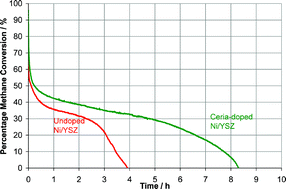Numerous investigations have been carried out into the conversion of biogas into synthesis gas (a mixture of H2 + CO) over Ni/YSZ anode cermet catalysts. Biogas is a variable mixture of gases consisting predominantly of methane and carbon dioxide (usually in a 2 : 1 ratio, but variable with source), with other constituents including sulfur-containing gases such as hydrogen sulfide, which can cause sulfur poisoning of nickel catalysts. The effect of temperature on carbon deposition and sulfur poisoning of 90 : 10 mol% Ni/YSZ under biogas conversion conditions has been investigated by carrying out a series of catalytic reactions of methane-rich (2 : 1) CH4/CO2 mixtures in the absence and presence of H2S over the temperature range 750–1000 °C. The effect of ceria-doping on carbon dioxide reforming, carbon deposition and sulfur tolerance has also been investigated by carrying out a similar series of reactions over ceria-doped Ni/YSZ. Ceria was doped at 5 mol% of the nickel content to give an anode catalyst composition of 85.5 : 4.5 : 10 mol% Ni/CeO2/YSZ. Reactions were followed using quadrupolar mass spectrometry (QMS) and the amount of carbon deposition was analysed by subjecting the reacted catalyst samples to a post-reaction temperature programmed oxidation (TPO). On undoped Ni/YSZ, carbon deposition occurred predominantly through thermal decomposition of methane. Ceria-doping significantly suppressed methane decomposition and at high temperatures simultaneously promoted the reverse Boudouard reaction, significantly lowering carbon deposition. Sulfur poisoning of Ni/YSZ occurred in two phases, the first of which caused the most activity loss and was accelerated on increasing the reaction temperature, while the second phase had greater stability and became more favourable with increasing reaction temperature. Adding H2S significantly inhibited methane decomposition, resulting in much less carbon deposition. Ceria-doping significantly increased the sulfur tolerance of Ni/YSZ, however, in the presence of H2S ceria did not promote the reverse Boudouard reaction and at high temperatures carbon deposition was greater over ceria-doped Ni/YSZ. In order to further study the effects of ceria-doping, a solid oxide fuel cell (SOFC) was constructed with a ceria-doped anode cermet and its electrical performance on simulated biogas compared to hydrogen was tested. This fuel cell was subsequently ran for 1000 h on simulated biogas with no degradation in its overall electrical performance.

You have access to this article
 Please wait while we load your content...
Something went wrong. Try again?
Please wait while we load your content...
Something went wrong. Try again?


 Please wait while we load your content...
Please wait while we load your content...